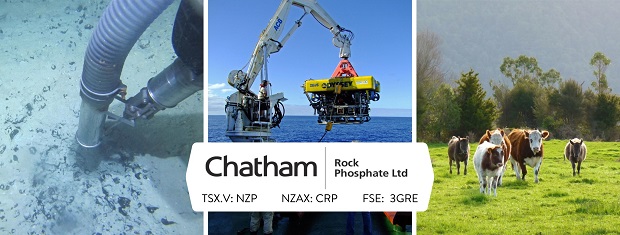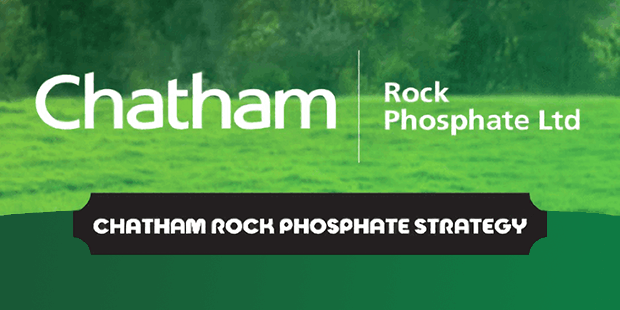
Chatham Rock Phosphate Limited (TSXV: “NZP” and NZX: “Chatham” or the “Company”) continues to make significant progress on its expanding portfolio of projects which now include rock phosphate, rare earths, and selenium. Other initiatives presently in their embryonic stages will be reported on in forthcoming releases.
Projects of National Significance
The Australia based rare earths and selenium projects are truly nation-building initiatives where Chatham intends to play a leading part.
As reported earlier, rare earths are now being classified in Australia as Critical Minerals.
Australia is a major non-China resource of Rare Earth Elements and has recently executed Critical Minerals agreements with South Korea.
Other relevant international developments include the USA legislating in favor of using non-China REE in defense material and Japanese interests signing an agreement for exploration and joint development in Queensland.
As reported earlier this month, Chatham has moved rapidly to become involved in the recovery of selenium by means of terrestrial mining (other selenium recovery technologies are also presently being investigated).
These initiatives were sparked by the release by the Queensland Government of its Resources Industry Development Plan, with six key focus areas and 43 nominated actions.
A key focus area is New Economy Minerals, (NEM) which include selenium and consequently we applied for an exploration area identified as having significant accumulations of selenium.
Exploration and resource definition costs are expected to be subsidised by the Queensland Department of Resources, which has set aside $26 million to fund their Collaborative Drilling Program in exploration areas for these new minerals.
Selenium is a critically important element that is used in photoelectric cells, light meters, TV cameras, photocopiers, solar cells and semi-conductors. Hence selenium is a key requirement for many aspects of the technology we routinely use in our daily lives.
Biologically, selenium is also necessary for human life. Its role is that of a cleanser or protector; it shields against cancers and other diseases by scavenging for free radical oxidants and some heavy metals. Natural selenium deficiency in rocks and soils may be related to the incidence of stroke in humans, and excess selenium can cause deformities and disease in animals.
As many soil types are selenium deficient in Australia and New Zealand, selenium needs to be either added to the soil directly, indirectly in fertilizers or fed directly to stock by way of drenching or lick blocks.
Selenium deficient soils are prevalent in Queensland as well as in New South Wales and West Australia while localised areas of selenium deficiency are to be found in South Australia, Victoria and Tasmania.
Selenium enriched limestone for use as an additive for fertilisers can sell for over $US5,000 a tonne, compared with medium grade rock phosphate presently selling at $US320 a tonne.
With our deep understanding of the fertilizer business and the importance of the trace mineral selenium for plant growth and animal health the opportunity was taken to apply for an exploration area in Central Queensland that was identified in our geological research as having significant accumulations of selenium.
The exploration area, north of Tambo, has outcropping beds of the seleniferous Toolebuc Formation as well as a recognised seleniferous soil profile.
The Queensland Department of Resources has accepted our application for an Exploration Licence EMPA 28606 over an area of 196 sq km in the Tambo region of Central West Queensland nominating selenium as the target.
The area is accessible by local paved roads and is well served by local infrastructure with the town of Blackall north of the area.
The shallow dipping beds of Toolebuc limestone are up to 20m thick. Initial exploration will involve soil sampling to identify the site of the highest selenium content underlying limestone for sampling by drilling.
With extensive existing geological data as well as water bores and the shallow nature of the limestone the exploration program will require limited drilling and analyses to prove up a JORC Resource.

Progress Report on our Rock Phosphate Projects
As previous detailed in numerous announcements since December 2020, Chatham has transformed from a single project company facing an uncertain and expensive permitting hurdle to a rapidly expanding group of projects much closer to generating operating cash flows with prospects further boosted by phosphate prices at 10-year highs.
The acquisition of Avenir Makatea was the first step in the Company’s strategy to build an international phosphate mining and trading house with a focus on low cadmium, organic phosphate.
The Makatea Project in French Polynesia is planned to produce 250,000 tpa with an expected start date of 2024.
The second step was the announced acquisition of the fully permitted Korella phosphate mine in Queensland, Australia with its ability to generate immediate positive cash flows.
The third step was the application for an exploration permit over a substantial area adjacent to the Korella phosphate mine to potentially increase phosphate reserves and associated rare earths. The 196 sq km area to the south of the Korella mine is called Korella South.
The fourth step, announced in January 2022, was the decision to take another value-adding step to its phosphate production with planned manufacturing of Monocalcium Phosphate (MCP). The MCP plant is planned to produce 30,000 tpa of MCP starting in 2025.
The fifth step, announced in May 2022 was the announcement concerning the commencement of a scoping study into a stand-alone 5Mtpa phosphate/fertilizer export facility in the Port of Townsville (Korella Terminal) with a complementary 2Mtpa phosphate export mine at Korella South.
The sixth phosphate-related new project concerned Korella North, announced last month when the application for phosphate exploration area designated EPMA 28589 (Korella North) was accepted by the Queensland Department of Resources (QDR). Korella North (EPMA 28589) covers an area of 6 square kilometers that contains a near surface phosphate deposit.
The area was exhaustively explored in 2007 and 2008 with soil sampling, trenching and drilling to prove the presence of outcropping phosphate of the Beetle Creek Formation along a strike length of approximately 1.5 kilometres. The formation is highly suitable for simple open cut mining.
Limited additional drilling and analysis within EPMA 28589 will enable a JORC-compliant resource estimate for phosphate and rare earth elements (REE) to be reported and transition to a Mining Lease to take place within a short time frame.
In summary, Chatham now has seven phosphate related initiatives underway and further additions are envisaged.
The existing phosphate projects are:
- Chatham Rise marine project in New Zealand, planned production rate 1.5 Mtpa from 2027
- Avenir Makatea – onshore phosphate mine/rehabilitation project, planned production rate 250,000 tpa
- Korella Mine – production rate 250,000 tpa once the acquisition is enforced
- Korella South – 2 Mtpa export focussed mine
- Korella North – 250,000 tpa production rate aimed at the domestic phosphate market
- Korella Terminals – 5Mtpa phosphate export facility to be established at the Port of Townsville. 2Mtpa rail loading facility located adjacent Korella North.
- Korella MCP- Cloncurry based monocalcium phosphate manufacturing plant expected to produce 30,000 tpa of MCP starting in 2025.
These projects already had attractive operating margins well before the recent surge in phosphate prices. Further, all the phosphate deposits concerned are ultra-low in cadmium, a food safety attribute already essential in Europe and likely to become a universal requirement. Ultra-low cadmium rock phosphate is relatively rare and will over time become an increasingly valuable and strategic resource.
Rare Earth Elements (REE)
Chatham Rock Phosphate Limited REE activities are now taking place under the umbrella of our 100% owned subsidiary Pacific Rare Earths Limited (PRE).
PRE was originally formed in 2018 to project-manage a Rare Earths Elements (REE) study on rock phosphate nodules and seafloor muds on the Chatham Rise.
PRE is now coordinating the scoping study for concentration of Total Rare Earth Oxides (TREO) from our proposed Korella Mine, Korella South and Korella North Exploration Areas.
Three Rare Earth Oxides, Yttrium, neodymium, and dysprosium, described as critical minerals and Heavy Rare Earth Elements, are found in abundance at Korella and Korella South as well as Chatham Rise.
Our REE Resources
- According to an independent report filed with the ASX in 2009, Korella Mine has an inferred yttrium JORC resource of 4.2 million tonnes at 746 g Y/tonne (i.e., 0.96 kg Y2O3/t)
- Neodymium and dysprosium were also identified at that time in both overlying sediments and the phosphate.
- Recent portable XRF analyses has shown the pervasiveness of both yttrium and neodymium in primarily the Korella phosphate.
- At the same time wet chemistry analysis of Korella phosphate samples has confirmed the presence of dysprosium and anomalous concentrations of gadolinium and samarium.
- Korella phosphate is the major host of the HREE.
The current sampling and testing program for Korella and Korella South to identify all HREE will be expanded progressively to quantify resources. The sampling program for HREE has been expanded to include the overlying duricrust and regolith.
Biomining of Rare Earth Elements
Earlier this month CRP advised research progress into extraction of rare earth elements from phosphate minerals by Chatham’s Pacific Rare Earths Limited.
The CSIRO work program was commissioned by Chatham’s wholly-owned Australian company, Avenir Makatea Pty Ltd.
Following encouraging results from stage 1 of culturing microbes potentially suitable for biomining, further testing will be conducted by CSIRO and Pacific Rare Earths, the trading name for Avenir Makatea.
Stage 1 testing conducted by CSIRO is part of an overall program to evaluate bioleaching to extract rare earth elements.
The first step was the successful enrichment of natural microbes present in three geologic horizons within Korella, Korella North and Korella South sites in NW Queensland.
Under controlled lab conditions, the native microbes were cultured and have demonstrated three orders of magnitude cell growth (i.e. from 106-107 to 109-1010 cells per mL) over a period of four days.
Additional subculturing of the cultures was conducted to further enrich native microbes.
Subject to continued success for the balance of the Stage 1 preparatory phase, CRP will commit to the series of longer duration bioleaching tests.
REE Processing and Enrichment Technology Advance
PRE recently engaged a third party to undertake sensor-based ore sorting of Korella phosphate testing in order to most effectively aid in REE enrichment.
In the first instance a 75kg sample of overlying silicious sediments and phosphate was tested. Initial results showed that sensor-based (density criteria) ore sorting was highly effective in separating phosphate from waste.
With HREE concentrated in the phosphate this has provided impetus to undertake further testing.
A one tonne sample of Run of Mine phosphate was sent for pilot plant testing to prove HREE concentration using sensor-based ore sorting technology.
On September 26 we were pleased to advise that initial testing of sensor-based ore sorting of Korella phosphate has shown particularly positive results.
Chatham engaged TOMRA Sorting to establish if their sensor-based sorting systems were capable of sorting Korella phosphate ore from waste material to improve the already relatively high-grade Direct Shipping Ore.
The test work demonstrated that Korella phosphate could be upgraded from a nominal feed of 30% P₂O₅ to a product in the range of 35% to 38% P₂O₅ at acceptable recovery rates.
Korella’s low cadmium phosphate in the range of 35% to 38% P₂O₅ is higher grade than most internationally traded rock phosphate (which is presently quoted at $US 320/t ex Casablanca and is particularly suitable for use by European fertilizer producers who previously depended on Russian appetite for supplies of high-quality phosphate.
In addition work is now underway to characterise the high silica waste rock from the ore sorting to establish its suitability for use in agriculture as a source of plant available silica and as a feed stock for the production of yellow phosphorus.
Marketing
Australia is a major non-China resource of Rare Earth Elements, now being classified in Australia as Critical Minerals. Australia has recently Critical Minerals agreements with South Korea.
Other relevant international developments include the USA legislating in favour of using non-China REE in defence materiel and Japanese interests signing an agreement for exploration and joint development in Queensland.
The PRE target market will involve the sale of TREO with 50% heavy rare earths content to Japan.
About Rare Earth Elements
Yttrium, neodymium, and dysprosium are the three critical minerals that are described as Heavy Rare Earth Elements.
They are present as an integral part of the technology supporting modern life. This includes magnets, computer hard drives, wind turbines, electric vehicles, lasers, TV/computer screens, exotic light sources and superconductors.
Recent market prices of these rare earth elements are (Source: Institut fur Seltene und Metalle AG)
- Yttrium oxide US$ 12.28 per kilo.
- Dysprosium oxide US$ 366.61 per kilo.
- Neodymium oxide US$ 129.54 per kilo.
- Gadolinium oxide US$ 66.48 per kilo.
- Samarium oxide US$ 3.71 per kilo.
Written by:
Chris Castle
President and Chief Executive Officer at Chatham Rock Phosphate Limited
64 21 55 81 85 or chris@crpl.co.nz






